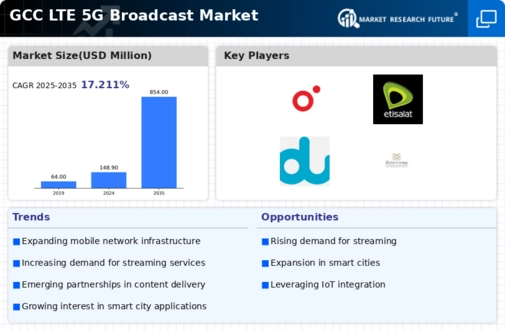The lte 5g-broadcast market is currently characterized by a dynamic competitive landscape, driven by rapid technological advancements and increasing demand for high-speed data services. Key players such as Qualcomm (US), Ericsson (SE), and Huawei (CN) are strategically positioned to leverage their extensive R&D capabilities and global reach. Qualcomm (US) focuses on innovation in chipsets that enhance broadcast capabilities, while Ericsson (SE) emphasizes partnerships with telecom operators to expand its service offerings. Huawei (CN) is actively pursuing regional expansion, particularly in emerging markets, which collectively shapes a competitive environment that is both collaborative and competitive.
In terms of business tactics, companies are increasingly localizing manufacturing and optimizing supply chains to enhance operational efficiency. The market appears moderately fragmented, with several key players exerting influence over various segments. This structure allows for a diverse range of offerings, catering to different customer needs while fostering competition among established and emerging players.
In October 2025, Qualcomm (US) announced a strategic partnership with a leading telecom operator in the GCC to enhance 5G broadcast capabilities. This collaboration aims to integrate advanced chipset technology with the operator's existing infrastructure, potentially improving service delivery and customer experience. The strategic importance of this move lies in Qualcomm's ability to solidify its market position by aligning with local operators, thereby enhancing its competitive edge in the region.
In September 2025, Ericsson (SE) launched a new suite of 5G broadcast solutions tailored for the GCC market, focusing on low-latency and high-efficiency broadcasting. This initiative is significant as it addresses the growing demand for real-time content delivery, particularly in sectors such as entertainment and sports. By introducing these solutions, Ericsson (SE) not only strengthens its product portfolio but also positions itself as a leader in the rapidly evolving broadcast landscape.
In August 2025, Huawei (CN) expanded its 5G broadcast network in collaboration with regional broadcasters, aiming to enhance content distribution capabilities. This strategic action is crucial as it allows Huawei (CN) to tap into the lucrative media sector, potentially increasing its market share. The partnership underscores Huawei's commitment to innovation and its ability to adapt to local market needs, which may further solidify its presence in the GCC.
As of November 2025, current competitive trends indicate a strong focus on digitalization, sustainability, and AI integration within the lte 5g-broadcast market. Strategic alliances are increasingly shaping the landscape, enabling companies to pool resources and expertise. Looking ahead, competitive differentiation is likely to evolve from traditional price-based competition to a focus on innovation, technology, and supply chain reliability. This shift suggests that companies that prioritize R&D and strategic partnerships will be better positioned to thrive in the future.

















Leave a Comment